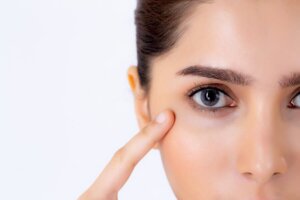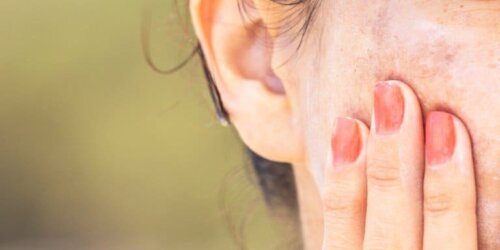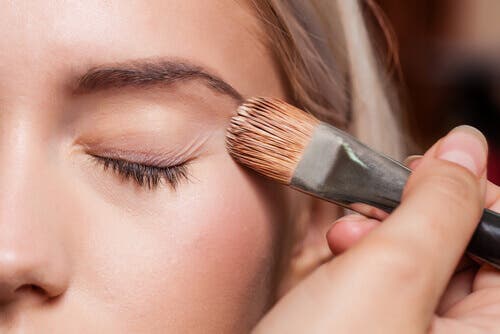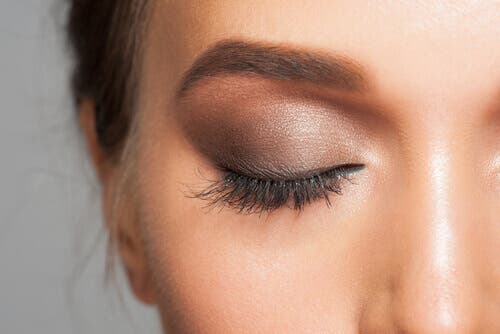Correct Dark Spots with Makeup Using these Tips


Written and verified by the nutritionist Eliana Delgado Villanueva
No one is perfect. You shouldn’t stop enjoying life just because you don’t have almond-shaped eyes, long eyelashes, or voluminous lips. Sometimes, however, you might want to use some makeup tricks to correct dark spots on your face.
Now for the million-dollar question: How can you correct dark spots with makeup?
Try the following tips to correct blemishes on your face and become an expert in retouching.
You might like: Prepare Your Skin for a Natural Finish Makeup
Types of dark spots
First, let’s take a look at the most common types of dark spots are.
Sunspots
Sunspots are the most common type of dark spots. Small in size and color, they are a solid brown color. Exposure to sunlight is the most common cause of these dark spots. However, they are easy to remove with laser treatments.
Hyperpigmentation

Facial hyperpigmentation is more common in women. However, using a sunscreen daily will help prevent the development of these spots.
Hyperpigmentation is caused by hormonal changes such as menopause, pregnancy, thyroid abnormalities, or taking birth control pills. It appears on the upper lip, cheeks, forehead, or chin. It’s more difficult to remove, but there are suitable treatments such as medical peels and depigmenting creams.
If the cause is hormonal changes due to taking birth control, hyperpigmentation should go away as soon as you stop taking it. Overall, 90% of women suffer from hyperpigmentation. However, in men, it mostly appears due to the use of antibiotics. For this reason, when taking certain medications, it’s always important to use appropriate sun protection.
Other types of stains:
- Metabolic or nutritional factors caused by a lack of vitamin C, B, or zinc.
- Inflammatory pigmentation caused by sunburn on the scar from a surgical operation.
- White spots often appear on arms and legs and are caused by sun damage. Also, as the skin ages, it doesn’t produce melanin, so it stays a whitish color. These spots may also be associated with liver or endocrinological disorders.
You might like: 5 Tips to Look Good without Makeup
Why do dark spots appear?
These spots usually appear from exposure to ultraviolet rays after years in contact with the sun, this is what is known as “photoaging”. Some tell-tale symptoms of photoaging include dehydration, peeling, and skin thinning, as well as a lack of elasticity in the skin resulting in wrinkles and homely blemishes.
The Spanish Society of Aesthetic Medicine (SEME) adds that the causes of skin aging are due to:
- Internal factors such as metabolic impairment and genetics.
- External factors such as solar radiation, pollution, environmental pollution, eating habits, alcohol consumption, tobacco, or stress.
How to use makeup to correct dark spots
1. The key is in the base

A suitable base will even out your skintone and reduce the appearance of dark spots.
For your base not to crack, crease, separate, cling to dry patches or melt off, you need to consider your skin type. On the one hand, oily skin will benefit from a light fluid applied with a moistened sponge. If your skin is very oily, you may want to consider using a mattifying foundation such as a stick or powder formula.
On the other hand, dry skin will benefit greatly from a hydrating, nourishing liquid, or cream foundation. The best way to apply it is with your hands or a brush, blending it all over.
Don’t forget your neck and ears. Press the foundation into your skin with the palms of your hands so it becomes invisible. Obviously, make sure to wash and disinfect your hands well before touching your face.
Finally, for normal skin, the best option is a moisturizing fluid or powder foundation that does not dry out your skin (don’t use a mattifying powder). Also, if you already have mature skin, you do best with a creamy anti-aging formula or a fluid foundation with a toning effect.
2. Concealer to correct blemishes
For each of these types of spots, different concealers help cover them up. Make sure you are always using the right undertone for your skin (cool, neutral, or warm), just as you would for your foundation.
- Apply light concealer to hide dark spots, dark circles, and pimples. You may also apply a lighter shade to sunken areas of the face due to age or stress.
- Darker shades of concealer can improve the appearance of more undesirable features such as a double chin or wider sides of the nose. You can use a darker concealer to contour if you choose.
- Green concealer will hide redness and veins but be sure to apply a normal shade on top. The green will cancel out the redness but you don’t want to be left with green spots!
3. Play up your eyes to correct blemishes

Combine the tones that best suit your needs and go for a deep and radiant look.
- Eyeshadow: Light and bright shades make your eyes more prominent, while dark tones give your eyes drama and depth, but could make them appear smaller.
- Mascara: There are mascaras that lengthen, volumize and thicken lashes, as well as curl them. There are even clear mascaras!
- Eyeliner: Essential for modifying the eye shape or making your eyes stand out. If you use a pencil or shadow liner, your look will be more natural. You may use liquid if you’re going for a more graphic or sophisticated look.
Finally, you may want to follow up on these tips to correct dark spots with a visit to your dermatologist and/or esthetician. They will be able to provide you with skin treatments and/or skincare regimens and products that will help reduce dark spots so you don’t have to cover them up.
In addition, use a setting spray on your makeup to make it last all day.
All cited sources were thoroughly reviewed by our team to ensure their quality, reliability, currency, and validity. The bibliography of this article was considered reliable and of academic or scientific accuracy.
- Pérez Martell Tamara M, González García Isahiris. Rev. Med. Electrón. [Internet]. 2011 Dic [citado 2019 Mar 24] ; 33( 6 ): 728-737.
- Mora Ochoa Moraima, Olivares Savigñon Alvis Rosa, González Gross Tania María, Castro Mela Inés. El sol: ¿enemigo de nuestra piel?. MEDISAN [Internet]. 2010 Agosto; 14( 6 ).
- Sagaro Delgado B. Radiación y reacciones cutáneas. En: Manssur Katrib J, Díaz Almeida J, Cortes Hernández M. Dermatología. La Habana: Editorial Ciencias Médicas, 2002:95-109.
- MedlinePlus. Lentigo solar. https://medlineplus.gov/spanish/ency/esp_imagepages/2435.htm
- MedlinePlus. Melasma. https://medlineplus.gov/spanish/ency/article/000836.htm
- Actas Dermo-Sifiliográficas. Volume 101, Issue 8, October 2010, Pages 659-672. Novedades en fotoprotección. https://www.sciencedirect.com/science/article/abs/pii/S0001731010002760
- González-Guerra, Elena. Errasti Alcalá, Tania. Guerra-Tapia, Aurora. Envejecimiento cutáneo: causas y tratamiento. http://www.masdermatologia.com/PDF/0190.pdf
- Manual MSD. Enfermedad de Addison. https://www.msdmanuals.com/es-ar/hogar/trastornos-hormonales-y-metab%C3%B3licos/trastornos-de-las-gl%C3%A1ndulas-suprarrenales/enfermedad-de-addison
This text is provided for informational purposes only and does not replace consultation with a professional. If in doubt, consult your specialist.








